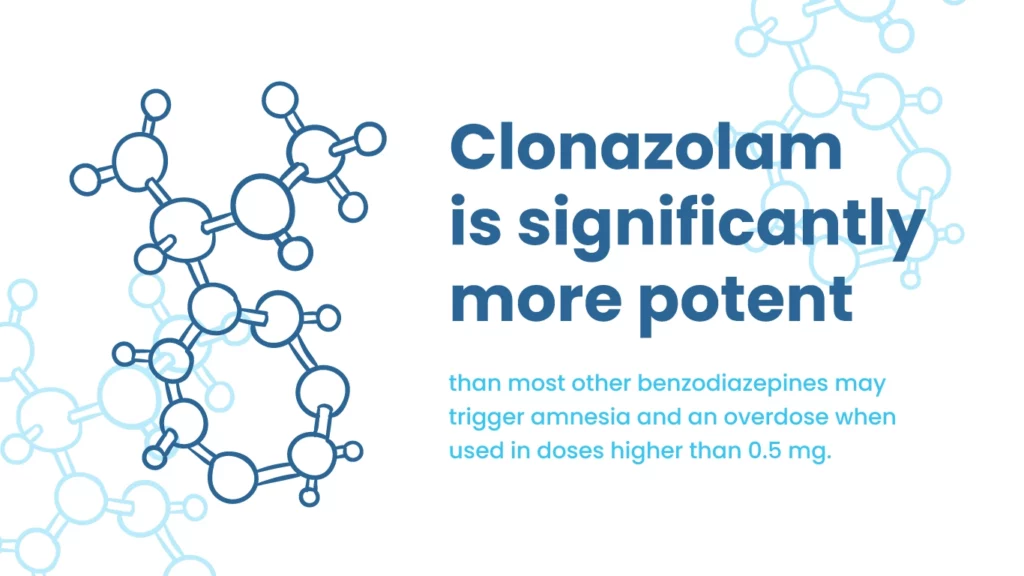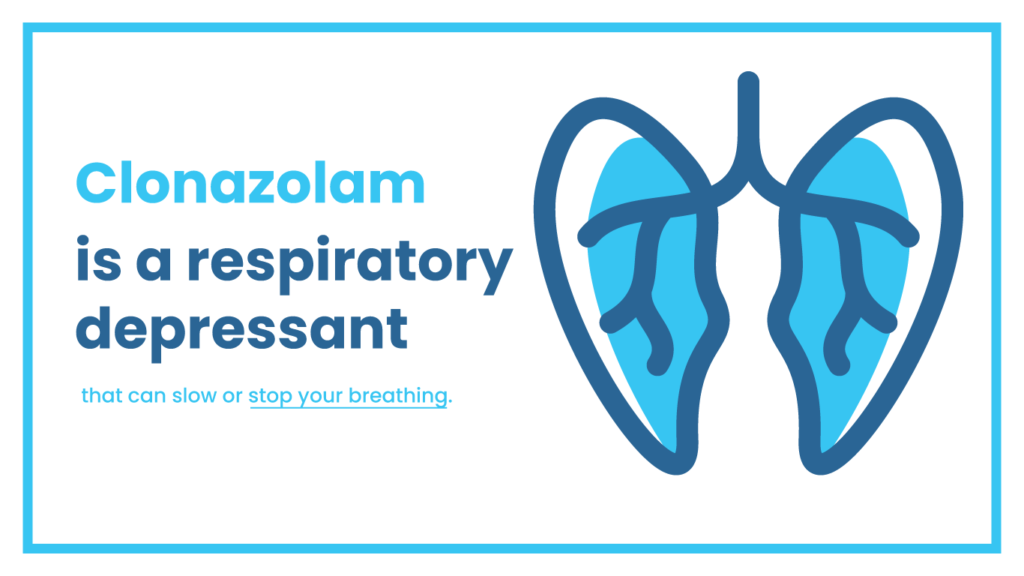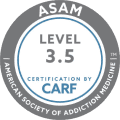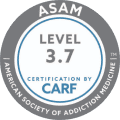Clonazolam is a relatively new “designer” drug that is highly potent and can cause problems with physical dependence and addiction. Knowing more about what clonazolam is and about the risks associated with using it can help you and your loved ones stay safe and well informed.
What Is Clonazolam?
Clonazolam is a benzodiazepine derivative, or designer benzodiazepine. This means it is created solely to produce euphoria in those who practice recreational drug use. It mimics the effects of prescription benzodiazepines but is considered a research chemical with no accepted medical use.
In terms of chemistry, clonazolam is fused with a triazole ring. A triazole is a compound that has two carbon atoms and three nitrogen atoms. This psychoactive substance is significantly more potent than most other benzodiazepines and may trigger amnesia and an overdose when used in doses higher than 0.5 mg.
Clonazolam is not legal in the United States. In Minnesota and Virginia, it is considered a Schedule I drug alongside heroin and LSD. Using any amount of clonazolam can be extremely dangerous, given how it is not regulated and could contain harmful ingredients and other drugs like fentanyl.
The University of Washington says designer drugs like clonazolam usually come in pills that have the same color and appearance as Xanax. Steering clear of counterfeit Xanax sold on the streets can also help you avoid being exposed to clonazolam.

Why Would Someone Use Clonazolam?
Designer substances like clonazolam are usually used by people who engage in recreational drug use to get high. They may also be used by people who are addicted to benzodiazepines and who cannot get them legally from their healthcare providers. Mental health disorders are another common risk factor for illicit drug use, as people with mental illnesses may use drugs like clonazolam to reduce or escape their symptoms.
Benzodiazepines are typically prescribed to treat anxiety and insomnia. These medications are central nervous system (CNS) depressants that slow down CNS processes like breathing and heart rate. As a result, these drugs can make you feel extremely sleepy and relaxed, especially when used in high doses.
Anyone who enjoys the effects of benzodiazepines may try using clonazolam. Other risk factors for drug misuse include peer pressure, early exposure, and a family history of addiction.
What Are the Effects of Clonazolam?
Clonazolam is designed to mimic the effects of other benzodiazepines, but it is far more potent and more likely to cause strong sedation. According to a 2020 study published in Forensic Science International, its other effects include loss of muscle tone, deep tendon reflexes, and long-term coma. It may also cause euphoria, amnesia, muscle relaxation, reduced anxiety, fatigue, and sleepiness.
Benzodiazepines like clonazolam interact with a brain chemical called gamma-aminobutyric acid (GABA) that plays an important role in many bodily processes including sleep and mood. Changes to GABA activity in the brain are what trigger the effects caused by clonazolam.
The clonazolam you use may produce additional effects than those mentioned above, especially if it is mixed with other substances like opioids and stimulants. The effects of clonazolam can be unpredictable, as the type of ingredients and their amounts may vary from one batch to the next. Avoid using any clonazolam at all if possible, as you will never know exactly what is in this drug if you are buying it from dealers on the street.
What Causes a Clonazolam Overdose?
Anyone who uses clonazolam can experience an overdose regardless of the amount being used, or whether the person has developed a tolerance for other types of benzodiazepines. The potency of clonazolam may differ from one batch to the next since it is made in illegal labs and may even be mixed with other substances. Even someone who has been using higher doses of benzodiazepines and has developed a high tolerance can suffer an overdose after using clonazolam just one time.
Sedatives like clonazolam are respiratory depressants that can slow or stop your breathing. Unfortunately, they can also slow or stop your heart rate.
Signs and symptoms of a clonazolam overdose are the same as those of any other benzodiazepine. According to the DEA, these signs and symptoms include:
• Extreme drowsiness
• Confusion
• Impaired coordination
• Decreased reflexes
• Slowed or stopped breathing
• Loss of consciousness
• Strong sedation
• Coma
• Death
Get emergency medical help right away if you or someone else is experiencing any of the above symptoms after using clonazolam. Unlike an opioid overdose that can be reversed with naloxone, a benzodiazepine overdose cannot always be reversed and may result in death.

Is Clonazolam Addictive and Habit-Forming?
Clonazolam is highly addictive and habit-forming like heroin and other Schedule I drugs. Most prescription benzodiazepines are Schedule IV drugs that can lead to physical dependence and addiction when used regularly for between two and four weeks. Clonazolam may lead to addiction even sooner due to its higher potency.
The physical dependence on clonazolam is characterized by a specific set of withdrawal symptoms that can occur when you suddenly stop using this drug after a period of regular use. Clonazolam withdrawal symptoms are the same as those produced by other benzodiazepines and include nausea, vomiting, and headache.
Other clonazolam withdrawal symptoms include:
• Headache
• Heart palpitations
• Sweating
• Shaking
• Nausea and vomiting
• Diarrhea
• Muscle pain and stiffness
• Dizziness
• Fainting
• Restlessness
• Insomnia
• Irritability
• Agitation
• Panic attacks
• Poor memory and concentration
• Blurred vision
• Depression
• Delirium
• Paranoia
• Hallucinations
• Grand mal seizures
Addiction to clonazolam tends to develop later on after you become physically dependent. Addiction is characterized by a set of compulsive behaviors related to drug use that is difficult to control. For example, you may be addicted to clonazolam if you skip work or school to use this drug, or if you keep using it even though you know it is causing other health problems, like depression or lung dysfunction.
What Is Medical Detox, and How Does it Help With Clonazolam Withdrawal?
Medical detox is a treatment for physical drug and alcohol dependence. It helps you safely withdraw from drugs like clonazolam while facing a reduced risk of complications like seizures. It also minimizes the severity of your withdrawal symptoms to make you feel more comfortable during treatment.
Medical detox is always the first stage of treatment for clonazolam addiction at a drug rehab center. Your treatment team will put you on a tapering schedule, which involves replacing your usual dose of clonazolam with an equivalent dose of diazepam, and reducing your dosage gradually over several weeks. Your detox treatment will be over when you no longer experience clonazolam withdrawal symptoms.
Combining clonazolam with other drugs can put you at an increased risk for other serious problems like organ failure. If you were using clonazolam with other substances like alcohol or opioids, your detox treatment may involve the use of other medications and treatments that can relieve your symptoms and help you avoid these other complications.
After detox is complete, you can transition into a residential drug rehab program to receive counseling and behavioral therapy for clonazolam addiction.

How Is Clonazolam Misuse Treated at Drug Rehab?
Drug rehab programs use a variety of therapies to address the root causes of your addiction and help you achieve long-term recovery. Rehab programs usually last between 30 and 90 days, though 120-day programs are also available for those who need more time in which to recover from drug misuse.
The therapies you receive at drug rehab will depend mainly on the reasons you started using clonazolam in the first place. For example, if you started taking clonazolam to deal with stress, your treatment may include stress management training, which teaches you how to manage stress in healthier ways such as through exercise or meditation. If you started using clonazolam to cope with a mental health disorder, your treatment may include dual diagnosis therapy, which teaches you how to abstain from drugs while living with your mental illness.
After your residential rehab program ends, your treatment team may recommend transitioning to an outpatient program so you can resume your work and personal lives while still receiving therapy. Outpatient rehab usually meets one or more days a week and includes 12-step support group meetings like Narcotics Anonymous.
The best drug rehab centers will customize your treatment based on the underlying causes of your addiction and clonazolam misuse. Look for a rehab center that offers both medical detox and residential rehab, as these programs can help you recover from your substance use disorder in full.
Where Can I Find Clonazolam Addiction Treatment?
Clonazolam addiction is a relatively new type of substance use disorder, therefore, it should be treated only by industry professionals who have experience with designer drugs.
The Haven New England is a premier drug and alcohol detox center that can help you recover from clonazolam dependence. We also offer a residential rehab program you can transition into after you complete clonazolam detox. Contact us today at (844) 933-4145 to learn more about your available addiction treatment options and get started on the path to recovery.



